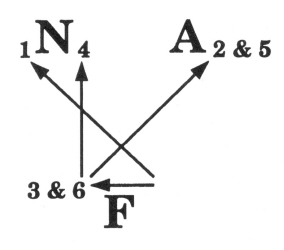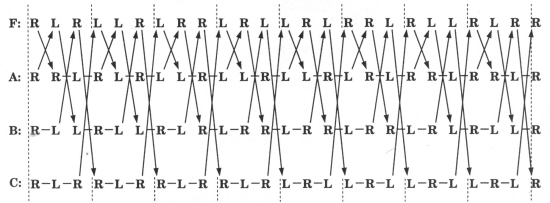|
Martin's
Psychosis With
Nathan and Art as feedees, I went back
to attempting to make a feed of Jim's 3Count without using
the handacross that had resulted in Martin's Madness. The result was
this pattern, which I found harder to learn; but then I'm used to
doing the forced handacross in other patterns and it kept sneaking in
here even when I was trying not to do it. I told Art that I was
calling the handacross pattern Martin's Madness, so Art, knowing that
I considered this pattern less natural, said we should call it
Martin's Psychosis.
Again
we'll have the feeder throw diagonally and the feedees straight (but
you could reverse that and do Martin's Neurosis). If the feedees go
with the flow, they don't actually have to know what their sequences
are, which makes it easier. It's just done with Jim's 3-Count in mind
- always pass, in a 3count, the club that you just got passed.
The
feeder starts as in the Madness, for the first four throws. Pass a
pair of extreme crosses R-R and L-L, do a R-L self, and then do a
middle L-L pass. But at that point you're forced to make the next pass
(count 2 of the second pair) as another L-L (to the outside of the
second feedee).
This
is a hurry, and it's particularly strange because it's a hurried pass
(there's no such hurried pass in Jim's 3-Count). On top of that, the
feedees can accidentally make it so hurried that the feeder can't do
it!
To
avoid that the feedees should simply avoid getting ahead of the
feeder's rhythm during their two selves. Passes tend to be slower than
selves, so it isn't hard for a feedee, if not paying attention, to get
ahead. Try to avoid that.
Fig.
9 shows the causal diagram of the 18count cycle, and Fig. 10 shows
the feeder's first six throws. It turns out that each person has
Note
that the feedees here pass three R's in a row then three L's. But as I
said, if you just go with the flow (return the club you were passed),
you won't need to count or anything.
The
cycle is rather long, making it tricky for you as the feeder to
remember where you are. I find it helpful to count pairs of passes, Mob
Psychosis My
brain just about burned up the first time I tried this pattern - I
overloaded, trying to figure out the passes in real time by just going
with the flow. I'll describe the pattern here so that you can perhaps
enjoy the same sensation (I recommend it, though only in small doses).
I'll also suggest a way to do the pattern while preserving your
sanity.
Mob
Psychosis adds one feedee to Martin's Psychosis, thus filling out the
feeder's 3-count cycle - no selves remain. The feeder now passes to
the three feedees in turn, from left to right, in typewriter fashion,
while each of them feeder).
The
sequence of passes for each feedee is the same, although the three
feedees start at
In
order to feed this pattern, you should be able to feed the simpler
I-Count Typewriter Feed fairly fearlessly (see the Summer 1997
Juggler's Workshop). In that pattern, all throws are straight, there
are no hurries (but also no selves by the feeder) and hence you always
alternate Rand L throws.
In
Mob Psychosis, like in the Typewriter Feed, the feeder goes down the
row passing to each feedee till the end is reached and then jumps
(carriage returns) back to the left. But here the feeder's passes are
diagonal throws (RR or L-L) (though as usual you could instead have
the feeder throw straight and the feedees diagonally in Mob Neurosis).
The difficulty for the feeder is twofold: figuring out which hand to
pass from, and then figuring out which hand (of which person) to pass
to. You can theoretically try to do this by going with the flow, but
you don't have much time between passes to figure out what's next. Nor
is the feeder's sequence of rights and lefts short enough to remember
easily - at least at first.
But
at the recent IJA convention in Pittsburgh, I found a technique that's
very useful for making this pattern work. While I was trying to feed
Mob Psychosis, I asked a friend and fellow passer, Laura Provance, to
read to me my sequence of passes (rights and lefts) from my notes, in
groups of three (RLR, LLR, LRR, LRL, LRL, RRL, RLL, RLR). She would
read each group to me just before I had
To
work up to the full pattern, you may find it helpful to attack it in
steps. Start by doing just the first three throws. That's easy, so now
try the first six throws. Here the feeder should memorize (or have
someone read out loud) the |


